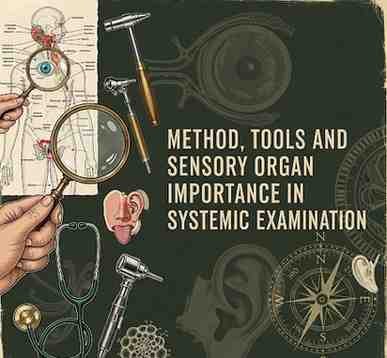
Your Account
Designed by Zeptt Technologies

Systemic examination in the context of Rachana Shareera aims to analyze the structure and function of individual body systems in a methodical manner.
Classical Ayurvedic texts emphasize the role of Indriyas (sensory organs), Pareeksha Vidhi (methods of examination), and Yantras (tools or instruments) for proper assessment of body systems.
In modern anatomy, systemic examination involves observation, palpation, percussion, auscultation, and specialized diagnostic tools.
METHOD OF EXAMINATION (PAREEKSHA VIDHI)
Darshana, Sparshana, Prashna are the three main tools of Trividha Pareeksha used for examining the body.
DARSHANA (INSPECTION)
Visual observation of physical features such as posture, color, swelling, asymmetry.
Useful in examining skin, eyes, gait, and deformities.
SPARSHANA (PALPATION/PERCUSSION/AUSCULTATION)
Palpation assesses temperature, tenderness, consistency, pulsation.
Percussion detects underlying fluid, air, or solid mass.
Auscultation is used for heart, lung, bowel sounds.
PRASHNA (INTERROGATION)
Involves systematic questioning to know symptoms, duration, aggravating or relieving factors.
Important in systemic history taking before physical examination.
TOOLS OF EXAMINATION (YANTRAS & MODERN INSTRUMENTS)
Ayurvedic View:
Traditional tools include Nadi Yantra, Mutra Patra, Jihva Patrika, Prakriti Pareeksha Chart.
Observation of sensory responses by stimulation with natural tools like ushna-jala, sheetala-jala, sparsha etc.
Modern View (as per BD Chaurasia):
Stethoscope – for auscultation of heart and lungs.
Sphygmomanometer – for measuring blood pressure.
Tuning Fork – for auditory examination.
Reflex Hammer – for testing deep tendon reflexes.
Ophthalmoscope – for eye examination.
Otoscope – for ear and tympanic membrane examination.
Pen Torch – for pupillary reflex and oral cavity examination.
Thermometer – to measure body temperature.
Measuring Tape & Weighing Scale – for anthropometric measurements.
Snellen Chart – for testing visual acuity.
IMPORTANCE OF SENSORY ORGANS (INDRIYA) IN SYSTEMIC EXAMINATION
Each Indriya (sensory organ) plays a crucial role in perception during systemic examination:
CHAKSHURINDRIYA (VISUAL ORGAN)
Observes physical characteristics, asymmetry, swelling, deformities, rashes.
Detects discoloration, gait, facial expressions, posture.
TVAKINDRIYA (TACTILE ORGAN)
Perceives warmth, tenderness, texture, rigidity, or softness.
Important in Sparshana Pareeksha.
GHRAANINDRIYA (OLFACTORY ORGAN)
Identifies odor of wounds, discharges, breath (useful in diagnosis of conditions like prameha).
RASAANINDRIYA (GUSTATORY ORGAN)
Evaluates taste disturbances during history taking, helpful in diagnosing Jwara, Agnimandya etc.
SHROTRINDRIYA (AUDITORY ORGAN)
Useful in auscultation (heart, lung, bowel sounds) and assessing patient’s speech.
MANAS (MIND AS A PERCEPTIVE FACULTY)
Coordinates all sensory inputs to derive meaningful understanding.
Important in interpreting responses during systemic examination.
INTEGRATION WITH MODERN HUMAN ANATOMY
Systemic Examination includes:
Nervous System: Cranial nerve exam, motor-sensory testing, reflexes.
Cardiovascular System: Inspection of chest, palpation of apex beat, auscultation for murmurs.
Respiratory System: Observation, chest expansion, breath sounds.
Digestive System: Abdominal palpation, auscultation of bowel sounds.
Musculoskeletal System: Range of motion, deformity check.
Endocrine System: Thyroid palpation, observation of signs like tremors, hair loss.
Importance of clinical correlation with anatomical structures for diagnosis is highlighted.